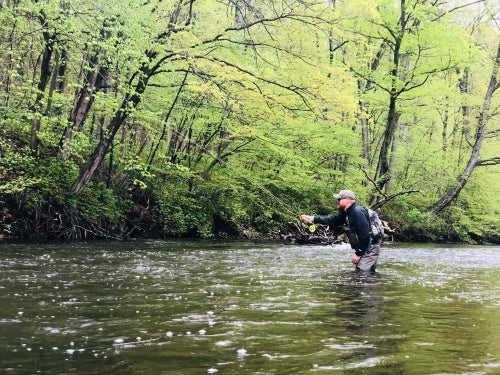Euro Nymphing Explained
In the past couple of years "Euro Nymphing" has taken the fly fishing industry by storm, and it is becoming very popular here in Michigan. At this point you have probably seen posts about it on social media, seen videos on youtube, read about it in your favorite fly fishing magazine, or heard about it from one of your fishing buddies who has dipped their toes into the world of euro nymphing. You have heard it called by many names: "czech nymphing", "modern nymphing", "tightline nymphing", etc. And you have probably heard that it is an incredibly effective method of trout fishing. All of this euro talk may have you euro curios and ready to take the plunge yourself. But as with any new-to-you fly fishing method it can be overwhelming and difficult to decipher where to start. Well don't worry, we are here to help.

The following are answers to some of the most common questions we hear from people interested in euro nymphing, along with some diagrams, videos, and gear recommendations that should help get you set up for success on the water.
What is "euro nymphing"?
Euro nymphing is simply a method of fishing nymphs for trout that was born from competitive fly fishing tournaments. Heavily weighted flies, and light tippet are used to quickly sink flies, and a "sighter" (multi colored section of monofilament) is used instead of an indicator (bobber).
The principle difference between euro nymphing and traditional nymphing (think thingamabobber and split shot) is that the angler maintains a tight connection between the flies and the rod tip throughout the drift. By eliminating the slack in the system the angler is able to detect even the subtlest of strikes and quickly set the hook.

What is a euro nymphing rod? Do I need one?
Euro nymphing rods are typically very light weight (2wt-4wt) and 10 feet long or more. That being said, you can certainly try this method with whatever rod you have right now, but if you really want to get into it, we recommend investing in a rod specifically for euro nymphing, and here are two important reasons why...
1. Reach. Since the angler is maintaining a tight connection between their rod tip and the flies while euro nymphing, the drift is only about as long as their reach. Therefore, a longer rod extends your reach and in turn your drift allowing you to cover more water effectively. This is why it is common practice for Euro nymphers to fish with their arm outstretched.

2. Sensitivity. Euro nymphing rods are designed with very soft tip sections which serve two purposes: sensitivity to detect strikes, and flex to protect light tippet. Often times you can feel a strike before you see it, an extra sensitive rod provides more tactile feedback than a traditional rod. Once you have hooked that fish of a lifetime on a 3wt rod and 6x tippet, now you have to land it. The soft tip sections of these rods help to absorb the shock of the battle and protect the light tippet.
We offer a number of euro nymphing rods from Echo and Orvis, and rod reel combo kits for any budget. Our staff favorite is by far the Echo Shadow X, check out the review here.

What type of fly line do I need?
A level line, because the fly line plays little role in loading the fly rod. The cast used in euro nymphing is a far cry from a river runs through it. The weight of the flies along with a water load is used to essentially fling the flies to the top of a run. We recommend a simple floating level line such as the Mastery Competition Nymph line from Scientific Anglers.
How do I build a euro nymphing leader?
There are countless euro nymphing leader recipes floating around out there and they can be a bit overwhelming. But here is what most of us here at the shop are using for our Michigan streams. You will need:
- Cortland Euro Nymph Leader Material
- Sighter Tippet (Cortland or Scientific Anglers)
- Cortland Ultra Premium Fluorocarbon Tippet or Scientific Anglers Absolute Fluorocarbon

You can also pick up a pre-made euro nymphing leader like this one from Scientific Anglers.
There are many many ways to spice up your Euro nymphing leader, if you want some more ideas check out our blog post on euro nymphing leader formulas.
What is a euro nymph? Are they different from regular nymphs?
The term Euro Nymph typically refers to any heavily weighted fly, often tied on a jig hook. These flies are usually tied with tungsten beads and lead wire so that they are particularly heavy. This eliminates the need for split shot and allows for a tight line connection between the flies and rod tip. The jig style hooks ride hook point up in the water reducing snags and aiding hook sets.

We love to tie flies, and there are tons of euro nymph patterns out there, and most of them are pretty easy to tie. But here are our top three that should be in every euro nympher's fly box:
2. Egan's Frenchie
3. Walts' Worm
For more ideas check out our Euro Nymph Playlist on YouTube.
How can I learn more?
Hopefully this page has answered some of your questions about euro nymphing, if you are interested in learning more stop by our Grand Rapids or East Lansing shop, or give us a call! Our employees will be happy to answer any further questions you may have. We also regularly host euro nymphing classes at each shop, and many of them are free! Check out our Class Schedule for upcoming classes.
Check out our Euro Nymphing Essentials page to browse euro nymphing related products all in one spot!
Finally, there are a number of books that go into extensive detail about euro nymphing, here are a few of our favorites:
